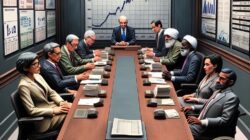Uncertainty Surrounds Upcoming Reciprocal Tariffs Following Court Ruling
By [Author Name]
Date: [Insert Date]
The Court’s Decision: Implications for Trade Policy
The recent court ruling has thrown the future of the broader reciprocal tariffs, which were set to roll out in July, into serious doubt. This unexpected legal outcome not only challenges the government’s trade policy but also opens up a debate about the effectiveness and necessity of these tariffs in the current economic climate.
Background on Reciprocal Tariffs
Reciprocal tariffs are designed to level the playing field between countries by imposing similar tariffs on goods that one nation exports to another. This policy is often employed to protect domestic industries from foreign competition, ultimately aiming to enhance local job growth and stabilize trade balances.
Details of the Court Ruling
The court ruling in question emerged from challenges filed by several industry groups and stakeholders who argued that the proposed tariffs would lead to increased costs for consumers and create uncertainty in the marketplace. Legal experts suggest that the decision underscores the tension between trade protectionism and free-market principles.
Potential Consequences of Delayed Implementation
The uncertainty surrounding the implementation of these tariffs could lead to several economic repercussions. Businesses that were preparing for the move may now face strategic dilemmas, adjusting their supply chains and pricing strategies in anticipation of different outcomes. Moreover, consumers may benefit in the short term from lower prices, but a prolonged delay could alter market dynamics significantly.
Industry Reactions
In the wake of the ruling, various industries have expressed their views, ranging from cautious optimism to outright concern. Manufacturing sectors that anticipated a boost from the tariffs may now have to reconsider their growth strategies. Conversely, import-dependent industries have welcomed the ruling, viewing it as a temporary reprieve from potential price hikes and market fluctuations.
Political Ramifications
The ruling also resonates on the political front, as trade policy has become a pivotal issue in recent years. Lawmakers now find themselves in a precarious position, balancing the interests of domestic businesses while appealing to increasingly globalized markets. The ruling may serve as a rallying point for both proponents and opponents of tariff implementations, potentially shaping the narratives leading into future elections.
The Road Ahead: What’s Next for Tariffs?
Looking forward, stakeholders are closely monitoring the situation as discussions on the next steps unfold. The government may choose to appeal the ruling, potentially prolonging the uncertainty. Alternatively, a revised approach to tariffs might be considered, one that accommodates the concerns raised during the legal challenges.
Public Sentiment and Economic Outlook
Public sentiment surrounding tariffs remains deeply divided, illustrating the complex nature of trade policies. Economic indicators suggest that while consumers may benefit from lower prices in the short term, the broader implications on employment and industry growth could foster a more challenging environment in the long run. Analysts will be keenly assessing data as it emerges in the wake of the ruling.
Conclusion
The court ruling raises a fundamental question regarding the anticipated implementation of reciprocal tariffs scheduled for July. As businesses and lawmakers navigate this uncertain landscape, the evolving narrative will undoubtedly shape the future of trade policy in the nation. Stakeholders will have to remain agile as they adapt to a continuously shifting trade environment.












